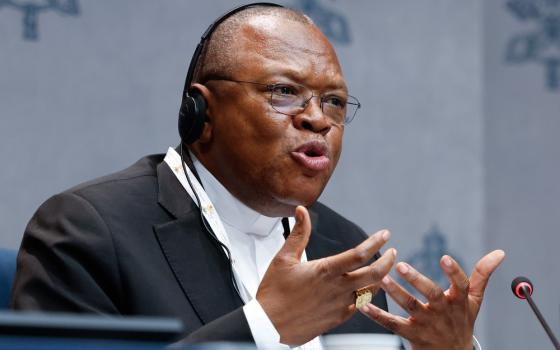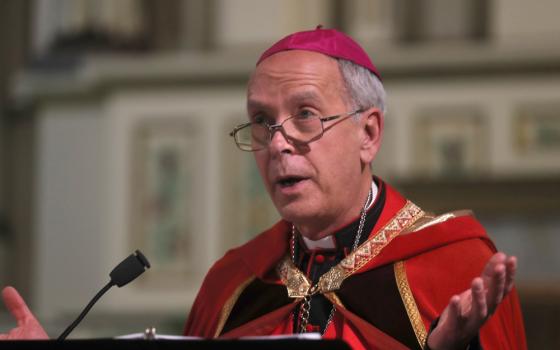
The most recent issue of Notre Dame Magazine includes a long piece called “Anything but clear,” about sexual assault at the university, my alma mater. Yet its 3,936 words do not include these two: Lizzy Seeberg. She was the 19-year-old freshman at St. Mary’s College in Notre Dame, Ind., who committed suicide in the fall of 2010 after accusing a University of Notre Dame football player of sexual assaulting her.
“The number of sexual misconduct allegations in the 2010-11 academic year was consistent with past averages,” the alumni magazine story says near the top, “but a course of events drew widespread attention at Notre Dame and elsewhere.”
End of sentence, end of paragraph, and end of story; nowhere else does the piece even obliquely allude to what these mysterious events might have been.
 Nowhere in the article, either, does it explain that the revamped assault policy it describes was negotiated as part of a settlement agreement with the federal government after the Seeberg case led the civil rights office of the Department of Education for the first time in at least 30 years to launch an investigation without waiting for a formal complaint to be filed.
Nowhere in the article, either, does it explain that the revamped assault policy it describes was negotiated as part of a settlement agreement with the federal government after the Seeberg case led the civil rights office of the Department of Education for the first time in at least 30 years to launch an investigation without waiting for a formal complaint to be filed.
 Nor does it say that that agreement allowed Notre Dame to get out in front of a possible civil rights finding that could have lost the school its federal funding under Title IX.
Nor does it say that that agreement allowed Notre Dame to get out in front of a possible civil rights finding that could have lost the school its federal funding under Title IX.
Across the country, of course, campus sexual assault is epidemic, and from Princeton University in New Jersey to the University of the Pacific in California, there is a terrible sameness to the aftermath of acts from which no one walks away whole: She talks, or doesn’t; he walks, almost without fail. This is not a new problem, either, but an intractable one, long suppressed, that’s only now being fully recognized.
In fact, since researchers started seriously keeping track, “we’ve gone 20 years with no significant change” in the 20 to 25 percent of women who are sexually assaulted during college, most often in the first days of freshman year, said S. Daniel Carter of the leading nonprofit advocacy group on this issue, Security on Campus. “It took 20 years to focus attention on the problem.”
As it turns out, even those Yale frat boys who were sanctioned last year for marching around chanting, “No means yes, yes means anal. No means yes, yes means anal,” had staged similar demonstrations every year for the last six years.
Like the politician who runs on family values, however, Notre Dame so heavily markets its morality that the university is particularly sensitive to such allegations. But there and elsewhere, damage control is part of the problem. And even when Notre Dame promised to change the way it handles sexual assault cases, in one of several recent “landmark settlement agreements” between longtime-offender institutions and the civil rights office of the Department of Education, the school spun the slap as a merit badge, and made clear in its press release that no major changes were ahead.
Russlynn Ali, the Obama administration’s assistant secretary for civil rights at the Department of Education, said in an interview that for the almost 40 years since Title IX barred discrimination against women at any school that receives federal dollars, her office has always had the authority to investigate, intervene and even withhold federal funding. But it was the Seeberg case that prompted the office, for “the first time in at least 30 years,” Ali said, to use its authority “to respond rapidly to an egregious case.”
The Seeberg case prompted the Department of Education’s office of civil rights to launch a seven-month probe into the way Notre Dame handles all sexual assault cases. That investigation ended in the summer of 2011 when the university agreed, among other things, to speed up investigations, offer victims a choice of whether they want university employees or local police to handle the complaint, and take additional steps to protect victims after incidents occur.
But Notre Dame’s announcement of the deal, on the Friday before the Fourth of July holiday weekend, said school officials had agreed to only “minor modifications” of what it characterized as “Notre Dame’s wide array of effective policies and procedures related to sexual misconduct.”
For years, says Kathy Redmond, director of the Denver-based National Coalition Against Violent Athletes, parents of victims at Notre Dame in particular “tell me they don’t want to go against the school when they know these guys are very protected” -- by students and alumni as well as administrators. Which may explain why “Notre Dame is by far, hands down, the leading school when it comes to sex assaults that are reported to my organization.” Notre Dame strongly denies there is any truth to Redmond’s assessment -- though I first read it in Notre Dame’s student paper, The Observer, long before the Seeberg case.
Just 5 percent of attacks are reported nationally, mostly because victim-blaming is rampant. And “perpetrators who think they won’t get caught, or actually haven’t been, keep doing it,” said Carter of Security on Campus. “If we’re ever going to break the cycle, survivors have to report.”
One of the most comprehensive surveys ever done, by the Chicago Tribune, found that on six campuses in Illinois and Indiana, police had investigated 171 reports of sex crimes since 2005, made 12 arrests, gotten four convictions -- and in six years at six schools, only one conviction in a student-on-student attack. With results like that, is it any wonder more victims don’t come forward?
Determined to change that, the Obama administration last April issued new federal guidelines on how sexual assaults on all campuses are reported and investigated, and sent Vice President Joe Biden himself out to announce the crackdown. “No means no if you’re drunk or sober,” Biden said in a speech at the University of New Hampshire in Durham. “No means no if you’re in bed, in a dorm or on the street. No means no even if you said yes at first and you changed your mind. No means no.”
There is no campus, of course, where such attacks don’t occur -- but there are places, including the University of Virginia, Harvard University and the University of New Hampshire, where long-standing programs are making a difference. The difference is not so much captured by numbers at this point as by the comfort level women report.
Notre Dame responded to the Seeberg case by insisting, to this day, that it was handled appropriately. At the end of a school year better-known for another student death, that of 19-year-old Declan Sullivan, who was videotaping football practice in 50 miles per hour winds when the scissor lift he was perched on toppled over, the school switched public relations directors, a change announced in a long press release about the importance of good messaging.
And as a result of the settlement agreement, a number of potentially important policy changes were made, including a “no contact” policy assuring that neither the accused nor anyone connected to him can get in touch with the accuser. But as the Notre Dame Magazine piece correctly notes, “Policy is never enough.”
Stories in this series
|

